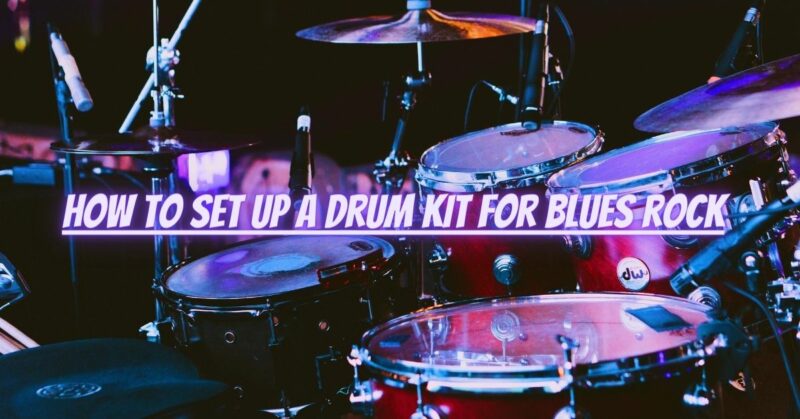Blues rock is a genre known for its soulful melodies, expressive guitar solos, and infectious grooves. As a drummer in a blues rock band, your drum kit plays a pivotal role in driving the rhythm and setting the stage for captivating performances. In this article, we will guide you through the process of setting up your drum kit for blues rock. From drum sizes and materials to cymbal choices and drumhead selection, we’ll explore the key elements to consider when configuring your kit to deliver that signature blues rock sound.
- Drum Sizes and Materials: Blues rock music often requires a balance between power and subtlety. Opt for drum sizes that offer a versatile range of tones, allowing you to deliver the necessary punch while maintaining dynamics. Consider a bass drum between 20 and 22 inches for a tight and focused low-end thump. Choose rack toms between 10 and 12 inches and a floor tom between 14 and 16 inches for a well-rounded sound with a warm and resonant tone. Drum shells made from mahogany or maple are popular choices for blues rock, as they provide a balanced combination of depth, warmth, and projection.
- Snare Drum Selection: The snare drum is a vital component of the blues rock sound, delivering the characteristic crack and snap that adds energy to the music. Look for a snare drum that offers sensitivity, versatility, and a wide tuning range. Consider a medium-sized snare drum, around 5.5 to 6.5 inches in depth, for a balance of attack and body. Choose a snare drum that provides a crisp and responsive sound, allowing for expressive playing and dynamic control. Experiment with different snare drum materials, such as wood or metal, to achieve the desired tonal characteristics and responsiveness.
- Cymbal Choices: Cymbals play a significant role in shaping the groove and enhancing the musicality of blues rock. Opt for cymbals that offer a warm and rich sound with a balanced mix of brightness and sustain. Choose a ride cymbal that provides a clear, defined ping and a versatile range of wash, allowing for controlled crashes and subtle ride patterns. Select crash cymbals that deliver a full-bodied sound with a medium decay, providing the perfect balance between explosiveness and musicality. Hi-hats should have a tight and articulate sound, allowing for crisp and precise footwork. Experiment with different cymbal sizes and weights to find the combination that complements your blues rock style.
- Drumhead Selection: Selecting the right drumheads is crucial for achieving the desired tone and response in blues rock drumming. Opt for drumheads that offer a balance between attack and warmth. Clear drumheads on the toms provide brightness and projection, allowing your drums to cut through the mix while still maintaining depth. Consider using coated drumheads on the snare drum to add warmth, enhance articulation, and deliver a controlled amount of sustain. For the bass drum, choose a drumhead that provides a focused and punchy sound, allowing for a tight and well-defined low-end. Experiment with different drumhead combinations and tunings to achieve the perfect blend of attack, tone, and resonance.
- Incorporate Blues-Inspired Accessories: To fully capture the essence of blues rock, consider incorporating blues-inspired drum accessories into your setup. Adding a felt strip or a bass drum pillow can help control the sustain and provide a dampened and focused sound that suits the blues rock style. Experiment with different types of brushes, rods, or specialty drumsticks to achieve the desired dynamics and nuances that enhance the blues rock groove.
Conclusion: Setting up your drum kit for blues rock requires careful consideration of drum sizes, materials, cymbal choices, drumhead selection, and the incorporation of blues-inspired accessories. By choosing drum sizes that offer a versatile range of tones, selecting a snare drum that delivers sensitivity and versatility, choosing cymbals that provide warmth and musicality, using drumheads that balance attack and warmth, and incorporating blues-inspired accessories, you can create a drum kit that sets the stage for captivating blues rock performances. Remember to immerse yourself in the blues rock genre by listening to iconic recordings, studying the drumming styles of influential blues rock drummers, and practicing with a focus on feel, groove, and musicality. With the right drum kit setup, you’ll be ready to unleash the groove and deliver the authentic blues rock sound that moves both your audience and your soul.


